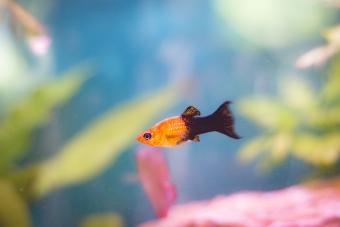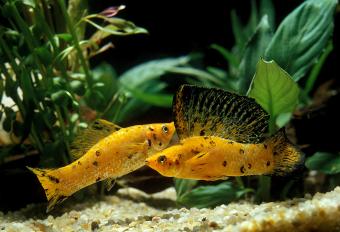
Watching your female molly go through the stages of pregnancy and birth is nothing short of amazing. This birthing experience is an adventure that's as rewarding as it is educational. Whether you're a seasoned fish keeper or a beginner eager to learn, the journey of raising molly babies is sure to teach you something new.
Breeding Mollies
Mollies are livebearer fish, which means they do not lay eggs. Instead, they gestate their young and give birth to them live. You will not need to do much to get mollies to breed as long as you have males and females in the same tank. Keeping the tank on the warmer side and feeding more insects can help encourage mollies to breed. Molly females can store sperm from the male for several months and can give multiple births up to one month apart from a single mating.
Mollies can reach sexual maturity as early as 2 to 3 months old, although it's better to wait until they're at least 6 months old before you consider breeding them.
The Gestation Period
Female mollies will gestate their young for about 60 days. They can give birth to between 40 and 100 fry. Mollies that are young or are having one of their first few pregnancies will tend to give birth to a smaller rather than larger number of fry. When a molly female is near her time to give birth, you will need to separate her from the rest of the tank. You can do this in the same tank using a breeding net or box, or you can put her in a completely separate holding tank.

When Your Pregnant Molly Is Ready for Birth
When it's time to give birth, the female molly will start acting a bit differently — more restless, perhaps seeking out quieter spots in the tank. Some fish keepers use a separate birthing tank or a breeding box to keep the mom-to-be and her upcoming fry safe from potential predators, but it's not strictly necessary if your main tank is well-designed with plenty of hiding spots.
Pregnant Molly Signs of Delivery
If you've got a pregnant molly fish, there are some clear signs that she's nearing the time for delivery. Her belly will noticeably expand and take on a rounded, fuller appearance. You may also observe a darker area near the back of her belly, commonly known as the gravid spot, which becomes more prominent as she gets closer to giving birth.
In terms of behavior, you'll often find the female molly becoming restless and possibly seeking quieter or more secluded spots in the tank. She may even hover near the bottom or close to the aquarium heater, avoiding the other fish. These changes in physical appearance and behavior are strong indicators that she's preparing to give birth, so you should be ready to welcome a new batch of molly fry.
DIY Birthing Tank
Creating a DIY birthing tank for your pregnant molly fish doesn't have to be an expensive venture. With a few basic supplies and a little time, you can set up a simple, safe space for your molly to give birth and for the fry to grow in their early stages.
What You Need
Setting up a birthing tank doesn't have to be a chore. Make it fun by incorporating decor. You can even add some baby decorations to make the experience more exciting. Aside from the welcoming baby decorations, here's what you'll need.
- An extra aquarium: A 5-10 gallon tank works well for this purpose. You don't need anything too big. You're not setting up a permanent home here.
- Aquarium heater: This will keep the water temperature stable between 72-78°F.
- Air pump with air stone: This keeps the tank aerated.
- Filter: A sponge filter is a good choice for fry, as it poses less of a risk for sucking them up compared to stronger filters.
- Hiding spots: Live or artificial plants, caves, or other hiding spots give fry places to hide safely.
- Lighting: This isn't absolutely necessary, but it helps if you want to observe the fish better.
- Water conditioner: Treat tap water and make it safe for both mom and fry.
Getting the Tank Together
Once you've gathered all the materials, follow these steps.
- Tank setup: Fill the spare tank with water and treat it with a water conditioner to remove chlorine and other harmful substances.
- Temperature and aeration: Install the heater and set the temperature. Attach the air pump and air stone to ensure good aeration.
- Install the filter: Add the sponge filter and let it run.
- Plants and hiding spots: Place plants and decorations in the tank to give the fry places to hide post-birth.
- Acclimate the fish: Before moving the pregnant molly, make sure the water parameters in both tanks are similar. Then, gently transfer her using a fish net or a cup.
- Lighting: Set up your light, but make sure there are periods of darkness, too, to mimic a natural environment.
- Observation: Once you've transferred the mom-to-be, keep an eye out for signs of birth. After she’s done, you may choose to move her back to the main tank to avoid her stressing out or potentially harming the fry.
Use a filter that has been in an established tank to transfer beneficial bacteria.

Helping Molly Moms and Newborn Mollies
Once the female has given birth, she should be returned to the main tank immediately. Otherwise there's a good chance she will eat her young.
Feed them baby brine shrimp, microworms, and ground up flakes. Provide lots of floating plants in their tank that they can hide in as they grow bigger. A heater is also important for growing fry to thrive.
Keeping Mollies Safe in the Communal Tank
Once the fry are released, the mother typically shows no further interest in them. This is where those hiding spots come in handy, as other fish in the tank might see the fry as a tasty snack. To give the fry the best chance at survival, keep them in the birthing tank or set up a tank solely for babies where they can safely grow without the threat of becoming someone else's dinner.
Keep baby mollies separate from the main tank until they have grown large enough that they are too big to be eaten by other fish. A suitable nursery tank will be around 10 gallons in size.
Adding Molly Fish to Your Aquarium Hobby
Mollies are a great fish choice for beginners interested in the fish birthing process. They're colorful and easy to care for, and breeding them can be a fascinating addition to your hobby. As long as you care properly for pregnant mothers and keep the baby fry safe, you can enjoy breeding and caring for this gentle fish.







